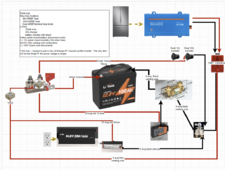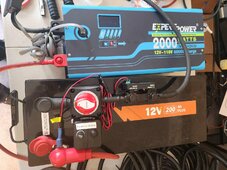I want to build my own UPS for my computer and appliances. Something that works just like the APC UPS that you can buy but I want to built the pack with LiFeP0 batteries. I want to be able to feed primary with my 110V power company feed and switch automatically to my pack in case the power fail just like an APC works. Can somebody guide me on this process?? I would greatly appreciate any help. Thanks!
You are using an out of date browser. It may not display this or other websites correctly.
You should upgrade or use an alternative browser.
You should upgrade or use an alternative browser.
Seeking Guidance on Building a Custom UPS with LiFePO4 Batteries
- Thread starter ZEUS-FL
- Start date
BentleyJ
Solar Wizard
A quality UPS does not Switch, it powers the load 100% of the time and uses utility power to float charge the battery. So if the grid goes down there is zero momentary loss of power to the sensitive load.
An inverter on the other hand normally would just pass-through utility power and the switching process does take a few milliseconds. Three solutions to get UPS like protection from an inverter with LFP batteries.
1) Purchase an inverter that has true UPS functionality.
2) Use an inverter with no AC input feature so its running on the LFP battery 100% of the time and use utility power with a stand alone charger to simply keep the batteries topped up.
3) Use a grid-interactive inverter that has a Peak Load Shave function. These are the most expensive type but are capable of blending utility and inverter power with user settable values for how much utility vs. battery power is used. If grid power is lost, the inverter is already running and the batteries will pick up the load with virtually no power disruption.
An inverter on the other hand normally would just pass-through utility power and the switching process does take a few milliseconds. Three solutions to get UPS like protection from an inverter with LFP batteries.
1) Purchase an inverter that has true UPS functionality.
2) Use an inverter with no AC input feature so its running on the LFP battery 100% of the time and use utility power with a stand alone charger to simply keep the batteries topped up.
3) Use a grid-interactive inverter that has a Peak Load Shave function. These are the most expensive type but are capable of blending utility and inverter power with user settable values for how much utility vs. battery power is used. If grid power is lost, the inverter is already running and the batteries will pick up the load with virtually no power disruption.
DIYrich
Solar Wizard
What is your budget and power needs?
Brucey
Solar Wizard
The Delta pro may or may not switch from AC grid to battery fast enough for PC ups purposes, can take up to 30 msec in "EPS" mode. If your PC power supply is highly loaded it may glitch out.I own already the batteries (16 EVE 105) I am willing to invest about $1,000 for this project. Maybe more if worth it.
I seen EcoFlow has this built in. I even was thinking on buy an Eco Flow Delta 2 Pro.

EcoFlow Delta Pro Through Manual Transfer Switch - Full Time Pertinent Circuits Home UPS
I have an existing manual transfer switch for pertinent circuits in my house, all under 2000 watts max and all 120v. Currently use a WEN 56200i with the transfer switch in a power outage that can handle the loads from these pertinent circuits with no problem. Our bigger issue lately isn't long...
I had no luck trying to charge my Delta 2 max from an external 36V battery, so doubt 48V would work either. Maybe Delta pro with it's higher solar input does bettér. 24V works fine with my d2m
DIYrich
Solar Wizard
EG4 3000, or Growatt 5000
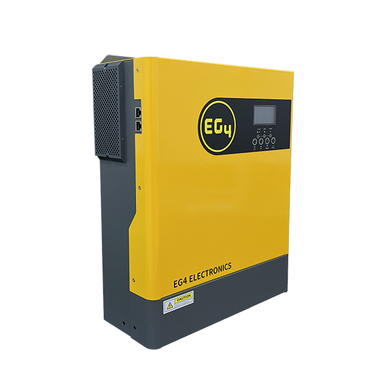
 signaturesolar.com
signaturesolar.com
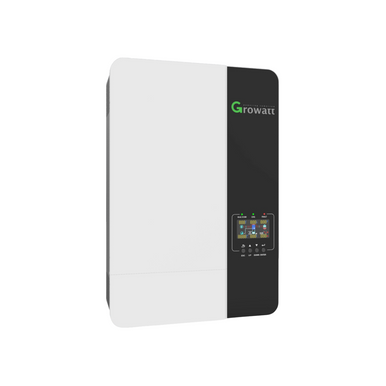
 signaturesolar.com
signaturesolar.com

EG4 3kW Off-Grid Inverter | 3000EHV-48 | 3000W Output | 5000W PV Input | 500 VOC Input
Power your off-grid setup with the EG4 3kW Off-Grid Inverter (Model 3000EHV-48), ensuring reliable energy conversion and performance for residential and small commercial applications.
 signaturesolar.com
signaturesolar.com

Growatt 5kW Stackable Off-Grid Inverter | SPF 5000US | UL 1741
Signature Solar provides solar panels, off-grid solar systems, grid-tie, and hybrid systems. Quality solar inverters, bifacial solar panels, complete solar kits, solar batteries. Featuring brands such as EG4 Electronics with their solar battery, LifePower4 and EG4 LLifePower4 and EG4 LL
 signaturesolar.com
signaturesolar.com
Maybe connecting a small 650VA APC to the Delta Pro so can act faster for the computer and then the Delta Pro will supply the APC. It should work. Just thinking loud.The Delta pro may or may not switch from AC grid to battery fast enough for PC ups purposes, can take up to 30 msec in "EPS" mode. If your PC power supply is highly loaded it may glitch out.

EcoFlow Delta Pro Through Manual Transfer Switch - Full Time Pertinent Circuits Home UPS
I have an existing manual transfer switch for pertinent circuits in my house, all under 2000 watts max and all 120v. Currently use a WEN 56200i with the transfer switch in a power outage that can handle the loads from these pertinent circuits with no problem. Our bigger issue lately isn't long...diysolarforum.com
I had no luck trying to charge my Delta 2 max from an external 36V battery, so doubt 48V would work either. Maybe Delta pro with it's higher solar input does bettér. 24V works fine with my d2m
Brucey
Solar Wizard
Yes that will work.Maybe connecting a small 650VA APC to the Delta Pro so can act faster for the computer and then the Delta Pro will supply the APC. It should work. Just thinking loud.
Brucey
Solar Wizard
One thing to be aware a fair few people seem to be having problems with their Delta pros.
If you already have 16 105Ah cells, build a 5.12kWh 48V battery assuming you have a BMS.
If your budget is $1000, get this inverter/charger and you are done. Has built in fast transfer switch and huge configurability. 10 year warranty if you buy through current connected who is a well regarded vendor with great reputation for customer service.

 www.currentconnected.com
www.currentconnected.com
Or bump up budget to $1250 or so and get the 3000VA model (UL listed version also available).
If you already have 16 105Ah cells, build a 5.12kWh 48V battery assuming you have a BMS.
If your budget is $1000, get this inverter/charger and you are done. Has built in fast transfer switch and huge configurability. 10 year warranty if you buy through current connected who is a well regarded vendor with great reputation for customer service.

Victron 48V MultiPlus 2kVA Inverter - 25A Charger | Current Connected
The Victron MultiPlus 48V 2kVA Inverter - Empower your energy system with adaptive tech, remote monitoring, and seamless backup power solutions.
 www.currentconnected.com
www.currentconnected.com
Or bump up budget to $1250 or so and get the 3000VA model (UL listed version also available).
KevinC_63559
New Member
Actually doing this exact project right now. Per my existing APC, my primary load is around 530W. I've opted for a Victron Compact from the kind folks over at Current Connected. It has a 2000VA inverter (call it 1600 watts to be safe), more than meeting my need. I opted for the 12V model with (2) 12V100A LiFePO4 batteries set up in parallel to feed it.
Along with the inverter I bought the required cables, a Victron MK3-USB, fuse holders and fuses. Spent a bit over $1100 plus tax and delivery (which would obviously vary based on where your at).
Yes, this system will drop power for about 20ms during an outage, but expect all my equipment to be able to ride through a 1/50th of a second outage, and Victron claims they will.
Nice thing I'll be able to do is current limit the recharge rate after an outage. Since I, like many in the USA, pay a peak demand, that should help minimize peak charges when power is restored. I plan on setting that to around 10amps, since I'm normally pulling half of that - plenty to cover the running need plus slowly recharge the batteries. I will feed it with a 20amp power cord out of my 20amp wall sockets, and have it feed a surge protected power strip I'll plug all the equipment into.
ps. I opted to go with the 12V system since I have some 12V needs in the area.
pps. Victron's 3000VA units are UL1741 listed, the 2000VA I went for is not; I'd probably do the 3000VA unit if I was ordering today.
Along with the inverter I bought the required cables, a Victron MK3-USB, fuse holders and fuses. Spent a bit over $1100 plus tax and delivery (which would obviously vary based on where your at).
Yes, this system will drop power for about 20ms during an outage, but expect all my equipment to be able to ride through a 1/50th of a second outage, and Victron claims they will.
Nice thing I'll be able to do is current limit the recharge rate after an outage. Since I, like many in the USA, pay a peak demand, that should help minimize peak charges when power is restored. I plan on setting that to around 10amps, since I'm normally pulling half of that - plenty to cover the running need plus slowly recharge the batteries. I will feed it with a 20amp power cord out of my 20amp wall sockets, and have it feed a surge protected power strip I'll plug all the equipment into.
ps. I opted to go with the 12V system since I have some 12V needs in the area.
pps. Victron's 3000VA units are UL1741 listed, the 2000VA I went for is not; I'd probably do the 3000VA unit if I was ordering today.
Last edited:
I really appreciate the response and options. I forgot mentioning that I need something more portable since this options looks like are large in size and more like stationary device for homes. I live in an apartment for the moment and I like to have portability around the apartment or If I want to move the device for camping etc.... I am really interested on the Victron option for a future.
Brucey
Solar Wizard
In that case I can recommend the Delta 2 max. Fans are pretty quiet for locating close to living quarters.I really appreciate the response and options. I forgot mentioning that I need something more portable since this options looks like are large in size and more like stationary device for homes. I live in an apartment for the moment and I like to have portability around the apartment or If I want to move the device for camping etc.... I am really interested on the Victron option for a future.
robbob2112
Doing more research, mosty harmless
For this sort of project I am using an Expertpower brand charger/inverter. It has a UPS function to it with a 5ms switchover on AC preferred or you can set for battery prefered and it runs the batteries down 40% then tops the batteries up. I am using the 2000w 12v unit, but they have other wattages and voltages.
6 months in and so far so good. It appears to be really similar to the sungold units externally. But, they claim usa design and mfg.
6 months in and so far so good. It appears to be really similar to the sungold units externally. But, they claim usa design and mfg.
DIYrich
Solar Wizard
16 eve 105 batteries are not what I would call "portable".
If you do a 12v system, then moving a case of 4 batteries would be portable. Hooking the case back up in parallel with the others is annoying (have to be all at the same voltage).
If you do a 12v system, then moving a case of 4 batteries would be portable. Hooking the case back up in parallel with the others is annoying (have to be all at the same voltage).
robbob2112
Doing more research, mosty harmless
For mine I am connected to a LiTime 200ah plus battery. Seems like it is 4s4p setup inside from the teardown video but I could be not remembering correctly. Either way the battery is 45lbs and the Expertpower unit is about that. So far from 'portable' if trying to carry it around. I put a powerpole SB350 connector in the line so I can separate the two parts to move it when needed.
Basically a bigger version of this, same general wiring diagram with different larger components and wiring. And the inverter also is charging so no separate charger. For the smaller cpap backup I have the charger on a timer so it comes on at noon when nobody is in the bedroom.
The other thing I did was paint the ends of the shunt with liquid electrical tape since I don't have a cover over it. I wish the mfg would include a cover or over the exposed metal. I suppose they don't expect the shuts to be used in a setup like this.
The precharge resistor is a 30ohm 25watt connected with 16awg wire and a fuse inline. It is connected across the switch so I push it for 10 seconds or so, then turn the switch on.
edit:
Attached a picture of my UPS setup - I forgot I reworked things with smaller wires and without the connector. I intend to put in a SB175 between the battery and inverter, but haven't done it yet.
Basically a bigger version of this, same general wiring diagram with different larger components and wiring. And the inverter also is charging so no separate charger. For the smaller cpap backup I have the charger on a timer so it comes on at noon when nobody is in the bedroom.
The other thing I did was paint the ends of the shunt with liquid electrical tape since I don't have a cover over it. I wish the mfg would include a cover or over the exposed metal. I suppose they don't expect the shuts to be used in a setup like this.
The precharge resistor is a 30ohm 25watt connected with 16awg wire and a fuse inline. It is connected across the switch so I push it for 10 seconds or so, then turn the switch on.
edit:
Attached a picture of my UPS setup - I forgot I reworked things with smaller wires and without the connector. I intend to put in a SB175 between the battery and inverter, but haven't done it yet.
Attachments
Last edited:
KevinC_63559
New Member
I really appreciate the response and options. I forgot mentioning that I need something more portable since this options looks like are large in size and more like stationary device for homes. I live in an apartment for the moment and I like to have portability around the apartment or If I want to move the device for camping etc.... I am really interested on the Victron option for a future.
I'm not sure portable, and using even a single 12V100amp LiFePO4 battery are compatible conversations. A single battery weighs about 25lbs. You could just hook it up to a cheap charge controller, and say a 500W full sinewave standalone inverter and have basic functionality. Package it all up and maybe your at 30 lbs. Just make sure the charge controller is designed for LiFePO4 batteries.
I'm thinking something like this inverter and a larger version of this charger. Add a cheap voltage display as a sanity check. Depends on your power requirements of course. Point is the charger could be smaller than your load, presuming you turn your PC off (or let it go to sleep), when not in use. Personally, I prefer the sleep option since it can be easily automated via Windows settings.
This would be a "poor mans" solution, but would come in at a few hundred dollars vs. a thousand. OK if you only use your PC a few hours a day. More than that, and you would need more battery and/or a bigger charger.
robbob2112
Doing more research, mosty harmless
My cpap UPS is a LiTime 12v 100ah mini, 19lbs. With the small 300w inverter I've had for years and the Litime 20amp charger. I went with the 20a charger because I tried a 10a charger first that was fanless, it was in a plastic case and it got so hot it was warping the case and releasing the adhesive under the stickers.
At any rate the battery + invert + charger will all fit inside the plastic case that holds hanging file folders. Put a strap around each end with a strap between and it weighs in at around 25lbs. It is capable of about 3 nights use in a pinch it might do part of a 4th night.
Weighs less than any number of my older "small" UPS like the apc backups 650 in the white case and weighs FAR less than the old 2200. My computer UPS weighs about the same as that old 220 (100lbs) but has 8 times the runtime when used.
So depends on what the OP means by portable.
Now in my case I run my cpap off the 12v direct with a car adapter. So I don't need an inverter at all and I leave the charger outside the case for ventilation.
At any rate the battery + invert + charger will all fit inside the plastic case that holds hanging file folders. Put a strap around each end with a strap between and it weighs in at around 25lbs. It is capable of about 3 nights use in a pinch it might do part of a 4th night.
Weighs less than any number of my older "small" UPS like the apc backups 650 in the white case and weighs FAR less than the old 2200. My computer UPS weighs about the same as that old 220 (100lbs) but has 8 times the runtime when used.
So depends on what the OP means by portable.
Now in my case I run my cpap off the 12v direct with a car adapter. So I don't need an inverter at all and I leave the charger outside the case for ventilation.
My cpap UPS is a LiTime 12v 100ah mini, 19lbs. With the small 300w inverter I've had for years and the Litime 20amp charger. I went with the 20a charger because I tried a 10a charger first that was fanless, it was in a plastic case and it got so hot it was warping the case and releasing the adhesive under the stickers.
At any rate the battery + invert + charger will all fit inside the plastic case that holds hanging file folders. Put a strap around each end with a strap between and it weighs in at around 25lbs. It is capable of about 3 nights use in a pinch it might do part of a 4th night.
Weighs less than any number of my older "small" UPS like the apc backups 650 in the white case and weighs FAR less than the old 2200. My computer UPS weighs about the same as that old 220 (100lbs) but has 8 times the runtime when used.
So depends on what the OP means by portable.
Now in my case I run my cpap off the 12v direct with a car adapter. So I don't need an inverter at all and I leave the charger outside the case for ventilation.
Robbob2112, I think a CPAP UPS is what my mom needs. Can you explain a bit more what your setup is—using small words. I am bit uncertain because you mention the Expertpower inverter, but then you mention a small 300W inverter.
Do you have a minimal true UPS for your CPAP?
Thank you
robbob2112
Doing more research, mosty harmless
Robbob2112, I think a CPAP UPS is what my mom needs. Can you explain a bit more what your setup is—using small words. I am bit uncertain because you mention the Expertpower inverter, but then you mention a small 300W inverter.
Do you have a minimal true UPS for your CPAP?
Thank you
Here is the minimal design for the cpap - removed the stuff that isn't needed for just that operation - you can also remove the shunt and battery monitor or get a cheaper version - I like to be able to tell at a glance how much power the cpap has.
No inverter required - I only has a victron inverter for running the fridge in an outage - this is the stripped down version.
I turned off the charger a week ago and it did 4 solid nights for me. Started beeping for low power when the battery hit 11v. It wasn't intentional but gave me a really good idea how far it would stretch. This was with both humidifier and heated tubing on.
I use the real deal with my resmed aircurve 10 asv machine - there are knock-offs but some people have issues. I never do with this.
DC Converter 24V 90W for AirSense/AirStart/AirCurve 10 CPAP Machines
The 24V 90W DC converter is compatible with ResMed's newest line of CPAP and bi-level series: the AirSense/AirStart 10 CPAPs and AirCurve 10 VPAP's.
I plug the charger into a common wall timer so it only charges in the day when I am not in the room - takes about 1.5 hours to charge from 75% to 100%
I got a sewing box from the good will for $2, but you can buy something new from walmart or amazon - this is as close as I could find

Get the wires from windy nation with the lugs already on them or make your own. Nothing fancy - just 10 awg wire for everything and a mix of 5/16 and 3/8 loops on the ends.
Here are links to what I used -
battery post fuse
https://www.amazon.com/Blue-Sea-Systems-MRBF-Terminal/dp/B00198FP8Y get 2 x 30amp
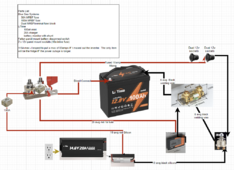
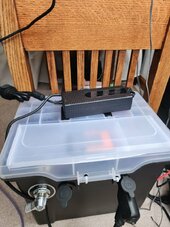
Last edited:
@robbob2112 thank you so much for that.
If you have time, would you mind looking over this thread?

 diysolarforum.com
diysolarforum.com
It starts as a more stripped down version of what you have, but is recommended to add fuses, etc.
The big difference is sunshine_eggo recommends switching to an AGM or Gel battery.
Electricity confuses me so the part that always weirds me out is the outlet and the charger are both connected to the battery poles, but the outlet does not get overpowered. I think I have a faulty mental model for electricity that makes it hard to understand.
Anyhow, if you have time to scan that thread and give your CPAP thumbs up or down I would be grateful.
If you have time, would you mind looking over this thread?

DIY CPAP UPS - LiFePO4 Battery - Dead Simple DC Power For CPAP
I felt like I was hijacking / monopolizing this awesome CPAP discussion: How to power a cpap ... so I thought our of respect for the guys in that thread, I'd start my own thread. :) Short Details: The SF Bay Area has had a lot of blackouts and my girlfriend's elderly Grandfather wants a...
It starts as a more stripped down version of what you have, but is recommended to add fuses, etc.
The big difference is sunshine_eggo recommends switching to an AGM or Gel battery.
Electricity confuses me so the part that always weirds me out is the outlet and the charger are both connected to the battery poles, but the outlet does not get overpowered. I think I have a faulty mental model for electricity that makes it hard to understand.
Anyhow, if you have time to scan that thread and give your CPAP thumbs up or down I would be grateful.
robbob2112
Doing more research, mosty harmless
LFP batteries have twice the usable energy density of AGM or FLA. A deep cycle marine battery AGM is generally 70ah at 12.8v. You don't take it down past 50% state of charge to not damage it. That leaves only 35ah of usable power. To match the 100ah LFP you would need 3 of them at about 50lbs each.
And they would be wasted after 3 years if not sooner unless you baby them. The little mini battery at 19lbs is actually cheaper when you factor in the costs.
In that thread @sunshine_eggo recommeded the switch to AGM because in that thread they use it as a pure backup source so the battery stays fully charged and is never used unless the power is out. LFP don't like to be stored at full charge, more like 50% SOC.
In the case of my design/unit I am always running from it every night. So I draw it down by 25% at night and the next day the wall timer the charger is plugged into kicks on and it charges the battery back up to 100%. I use a timer because the charger fans are louder than I like when I am in the same room. This method keeps cycling the LFP enough to make the electron gods happy and keep the battery healthy. I leave the wall charger for my ASV in the travel case for when we are on the go.
I tried a 10amp version of a charger that was in a plastic housing and it took 3.5hrs to charge up again and had nearly melted the case off. So I went back to the 20 amp Li Time charger in a metal case with a fan and haven't had an issue since.
I added in switches, battery monitor and fuse which are the current best practice. Need to be able to turn it off, protect the wires and see how much charge you have. You will notice every single wire has a fuse in it
And they would be wasted after 3 years if not sooner unless you baby them. The little mini battery at 19lbs is actually cheaper when you factor in the costs.
In that thread @sunshine_eggo recommeded the switch to AGM because in that thread they use it as a pure backup source so the battery stays fully charged and is never used unless the power is out. LFP don't like to be stored at full charge, more like 50% SOC.
In the case of my design/unit I am always running from it every night. So I draw it down by 25% at night and the next day the wall timer the charger is plugged into kicks on and it charges the battery back up to 100%. I use a timer because the charger fans are louder than I like when I am in the same room. This method keeps cycling the LFP enough to make the electron gods happy and keep the battery healthy. I leave the wall charger for my ASV in the travel case for when we are on the go.
I tried a 10amp version of a charger that was in a plastic housing and it took 3.5hrs to charge up again and had nearly melted the case off. So I went back to the 20 amp Li Time charger in a metal case with a fan and haven't had an issue since.
I added in switches, battery monitor and fuse which are the current best practice. Need to be able to turn it off, protect the wires and see how much charge you have. You will notice every single wire has a fuse in it
@robbob2112 thanks again. I am just getting my feet wet with some small RV charging and a solar golf cart project, and am trying to wrap my brain around the implications of different approaches. Thanks for taking the time to explain.
robbob2112
Doing more research, mosty harmless
@robbob2112 thanks again. I am just getting my feet wet with some small RV charging and a solar golf cart project, and am trying to wrap my brain around the implications of different approaches. Thanks for taking the time to explain.
Do you intend to do solar to for your mother's cpap?
No, Solar is the longer term plan. But I am starting to think about electricity use in different ways, like this little project to backup critical a function.Do you intend to do solar to for your mother's cpap?
robbob2112
Doing more research, mosty harmless
No, Solar is the longer term plan. But I am starting to think about electricity use in different ways, like this little project to backup critical a function.
To add solar to this you just need a SCC and a panel or 2 - brand of panel and SCC is up to you. If you look up your mother's address on pvwatts.com it will tell you how many hours a day you get sun. I tend to assume 4 hours for most places in the US.
You will use around 250 ~ 270 watt hours at night ... take 270
That is for 10 hours
So for this either two 100w 12v panels and a PWM controller or a single 100w panel with a MPPT controller. That is for summer... in winter you will either need more panels or to have it charge from wall power some of the time - i.e. set the wall timer for charging between 4 and 6pm... and the solar panels will gather what they can during the day.
PWM controllers are about 70% efficent at making power from sunlight because of how they work - so there is a lot of wasted energy.
MPPT controllers are around 98% efficent these days - so very little waste
PWM are cheaper
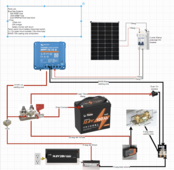
Similar threads
- Replies
- 13
- Views
- 774
- Replies
- 12
- Views
- 651
- Replies
- 17
- Views
- 1K



